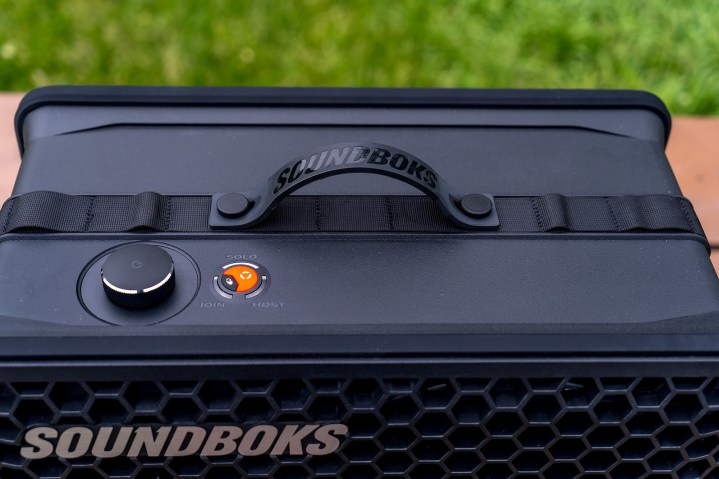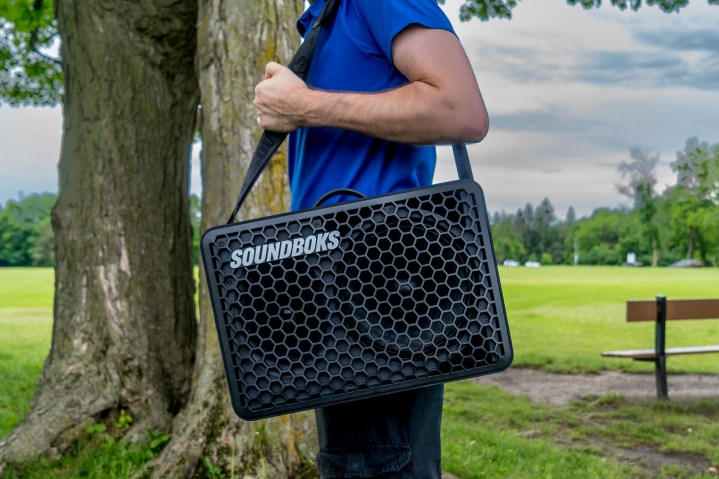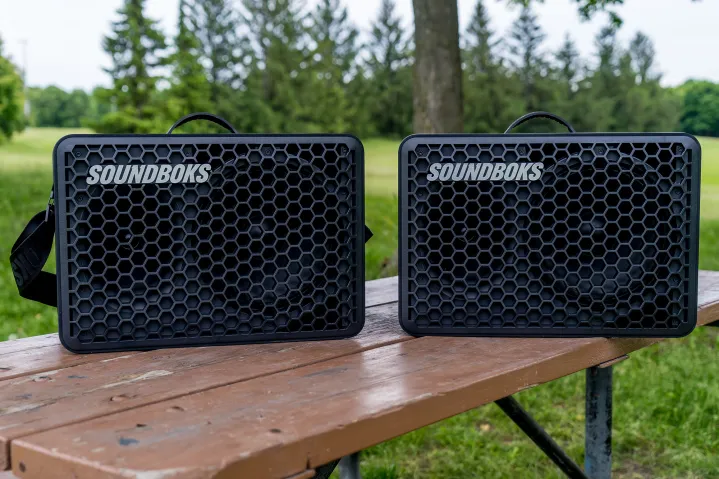Soundbox Go
MSRP $699.00
“The Soundboks Go will make sure any crowd starts bopping.”
pros
-
Great sound at loud volumes
-
Sturdy cabinet and bumpers
-
Good battery life
-
Effective app support
-
Awesome when paired with other speakers
cons
-
Not as useful indoors
-
Limited codec support
-
Pricey
Bluetooth speakers come in a wide variety of shapes, sizes, and styles. Some are super-portable, some are meant to be poolside pals, and others are happiest when you keep them at home. But if you want to rock an entire block party, or maybe even a small concert, you’re going to need some serious power.
That’s exactly where the $699 Soundbox Go finds its niche. This isn’t just a speaker, it’s a party in a box, and that means it can get loud. real loud We pumped it up to 11 to hear it for ourselves and whomever else showed up.
What’s in the box
Unboxing the Go won’t reveal much inside. Apart from the speaker itself, you get a battery, charging cables, and a user manual. While I did test out the speaker with the carrier strap, it’s a $50 add-on at the time of purchase (or $59 if you buy it later).
design
 Ted Kritsonis / Digital Trends
Ted Kritsonis / Digital Trends
I’ve previously listened to the larger flagship Soundboks Gen3, which is practically double the size of the Go, so I had a good sense of what I was getting into. The Gen3 is a monster of a speaker, sporting the kind of rumbling boom a DJ would want to keep a crowd bopping. So is the Soundbox Gen2, which is still available. The Go follows much of the same design philosophy, albeit in a smaller frame.
The grille in front is a carbon copy, as is the button layout and battery. In fact, the battery is exactly the same, so if you have a Gen3 already, you can use its battery with the Go. Soundboks has also ruggedized the Go as much as possible. It can effectively take a beating, and keep on playing, though I would certainly advise not being reckless given the speaker’s price tag. Rubberized silicone bumpers all around give it some good cushioning, while the cabinet can withstand heavy splashes of water, courtesy of its official IP65 rating.
 Ted Kritsonis / Digital Trends
Ted Kritsonis / Digital Trends
It weighs 20 pounds, so not the lightest thing to carry around, but once you park it somewhere, it’s good to go. A sturdy rubberized handle at the top is your ticket to lugging it around, unless you opt for the carrier strap, or you’re simply in the mood to treat it like an old-school boombox. It even has an opening at the bottom to mount it onto a compatible tripod or rig.
There’s a slot in the back to slide in the battery, which you plug into the power port nearby. You can also plug the wall charger directly into this same port if you plan to use this near a power outlet. Outdoors, however, you will probably need to rely on battery power a whole lot more, and buying an additional battery ($149) might become necessary.
The only other port is a 3.5mm Aux-In. Unlike the larger Gen3, there is no audio output or 1/4-inch input for microphones and guitars (or other instruments). You can still DJ with it if you want to, but you can’t get creative with instruments, unfortunately.
That’s kind of a shame, given the power the Go wields. It has two 72-watt Class D amplifiers, along with a 10-inch woofer and 1-inch silk dome tweeter. The speaker was built to push audio out in a linear direction, so it doesn’t have drivers facing the sides, back, or top, for instance.
Setup and configuration
 Ted Kritsonis / Digital Trends
Ted Kritsonis / Digital Trends
The volume dial doubles as the power button. Turn it on and a ring of LEDs light up to indicate volume level, which starts at zero and cheekily goes up to 11 — an in-joke that previous Soundboks speakers have also made. Each portion of the ring is a step in volume level, so you have a good idea where you stand at all times.
Next to that is a function button that splits into three based on what role the speaker is playing. The reason being that you can pair up to five Soundboks Go speakers together, with one acting as a host, while the others join. You can also choose to stereo pair them for left and right channels, which is great if you’re going to keep them aimed in the same direction. Or you can choose to keep them both in mono and place them in totally different spots to cover more ground. The Go speaks the same language as the Gen3, letting you pair a Go with a Gen3 should that ever materialize.
There is a neat workaround to get past the five-speaker restriction by way of the Aux-In port. Basically, you would need to set up two Go speakers as hosts, and then chain them together with a 3.5mm line-in cable. Soundboks doesn’t restrict how much you do this, so theoretically, you can put well over a dozen of them together playing the same audio, with full control through the Soundboks app.
 Ted Kritsonis / Digital Trends
Ted Kritsonis / Digital Trends
All of this wireless connection magic is handled via skaa, a wireless streaming protocol that uses the 2.4GHz frequency band, but is neither Wi-Fi nor Bluetooth. Skaa provides a lower latency connection with fewer dropouts than Bluetooth. If you choose to use the Skaa Pro Mode, it reduces latency even further and improves stereo sound. The only catch is that you max out at pairing two speakers (not four), and range drops by 20%, so you would have to position them a little closer to each other.
Bluetooth pairing with the Soundboks Go was initially more difficult than I expected. I used the Soundboks app to connect, and while it clearly saw the first speaker, it refused to make the connection. Finally, after what seemed like 15 attempts to do it, I broke through. I then added the second speaker, and that was it, pretty smooth sailing.
Using the Soundboxes app
It’s not deep with features, but the app does offer useful tools. First, it was nice to see that Soundboks continues to support its products with firmware updates. I noticed the same thing with the Gen3, and the Go was no exception during my time testing it.
Moving on, the existing sound modes are largely situational. If you’re outside and want to really hear what the Go can do, you choose Bass+. For something powerful, yet also mindful of battery life, you go with Power. Indoor is self-explanatory as the ideal route when inside. EQ lets you adjust the sound to your own liking, and save your favorites as presets.
The app lets you handle pairing multiple Go speakers, as well as settings for each one. Even a volume slider is there for you when you need to make adjustments. Other settings are pretty minimal outside of that, making it fairly easy to navigate your way around it.
sound quality
 Ted Kritsonis / Digital Trends
Ted Kritsonis / Digital Trends
Soundboks didn’t equip the Go with aptX codec support, and you don’t get hi-res codecs, like LDAC or aptX Adaptive, either. There is AAC at least. Clarity and quality definitely matter, but the Go’s purpose is to get loud with as little distortion as possible. It sounds great and does what it purports to do.
You come to realize pretty quickly that there are two tipping points to the speaker. For instance, in Bass+ mode, the difference from volume level five to six is significant. From nine to 10 or 11, it also hits a different gear. I found these respective thresholds applied to Power, Indoor, and EQ, though they naturally resonated differently. When I chose to tune my own EQ presets, the impact on sound was like sitting in between Bass+ and Power. You can get a cleaner balance this way, but Soundboks left its deepest bass response to the aptly named Bass+.
Not surprisingly, at least to me, the Go performed very well at high volumes. I could set it to, say, level eight or nine, and not really worry about distortion. It gets plenty loud at those levels, so a larger outdoor space with a sizable crowd would warrant going to nine or higher. It’s overkill in a backyard with closer proximity to other homes. Unless neighbors are joining the party, they’re going to eventually complain about the noise.
It was made for the beach, pool, backyard barbecue, or park bash.
Unlike the Gen3, however, the Go can push volume a little harder without bringing the proverbial roof down. I’m no DJ, but I can see one covering a good crowd with one or two Go speakers. Stereo paired together, they pack a serious punch.
Perhaps too serious for indoor use. Even with one of them playing singularly, I’m not sure this is the speaker you want if you plan to use it mostly inside. At level five or lower, there are plenty of other Bluetooth speakers that can match the sound quality and volume level, while coming in much lighter and smaller. The Go is an outdoor speaker first, and that may become patently obvious the moment you unbox it and feel how sturdy it is.
It was made for the beach, pool, backyard barbecue, or park bash. You could probably even get away with using it for other functions — maybe a small wedding or camping trip, among other things.
I also found the Skaa connection between the two speakers I tested worked well, though I can’t be absolutely certain of how much better the Pro Mode was compared to just leaving things, as is, with the regular Skaa connection.
battery life
 Ted Kritsonis / Digital Trends
Ted Kritsonis / Digital Trends
Battery life is highly contingent on what mode you’re using and how loud you’re going with it. Soundboks measures its battery estimates on full blast max volume. That’s why Bass+ will tap out at six hours, whereas Power will hit 10 hours. Play at mid-level volume, and that number can go all the way up to 40 hours. It’s all relative.
So it’s unsurprising. Bass+ goes up to 121 decibels at 11, so there’s a lot of power behind the loudness. That’s why extra batteries might be necessary if you plan to use the Go a lot in outdoor settings at the highest volume levels.
Our take
The Soundboks Go isn’t cheap at $699, or $749 if you want to throw in the carrier strap. It’s $149 for each extra battery. This can become an expensive proposition, but that often happens with a solid product that can serve particular niches or use cases. This isn’t the speaker for everyone, though it certainly can be the one for you if you know exactly what you’re going to do with it to entertain yourself and a crowd.
Is there a better alternative?
Other boxes like this do exist, and there is an interesting one in the Sony SRS-XP500. It has big sound, some lighting effects, and guitar and microphone inputs. Despite being heavier, it won’t be as rugged as the Go, and battery life maxes out at 20 hours, but quick charging for 10 minutes can get you an hour’s worth of playback. Plus, the lower $400 cost looks like a bargain in comparison.
For something somewhat comparable in size, and a little lighter at 16 pounds, the JBL party box Encore Essential takes JBL’s partybox into a smaller frame, yet retains many of the same features, including the fancy light show. Not to mention the more affordable $300 price. For something that shaves off a little size — and a whole lot of dollars — the Ion Audio Block Rocker Plus could be worth a look for a fraction of the Go’s price. It’s older, and doesn’t have waterproofing, nor an app to customize it, but it does have a handle with wheels and includes karaoke features.
How long will it last?
That really depends on how well you treat it. The IP65 rating is pretty rugged, but that doesn’t make the Go bulletproof against all the elements. Be careful near salt water and sand, as it will be hard to rid the speaker of either if they get into every nook. Soundboks offers a one-year warranty to cover malfunction issues — except for damage from water or sand.
Should you buy it?
Sure, if you have the space for it. I don’t just mean physical space for the Soundbox Go itself, but also open space outdoors or indoors where the speaker can get loud. You don’t have to crank it up to 11 every time to justify paying for it, but it would be a waste of power if you never pushed it beyond its default volume.
Editors’ Recommendations
